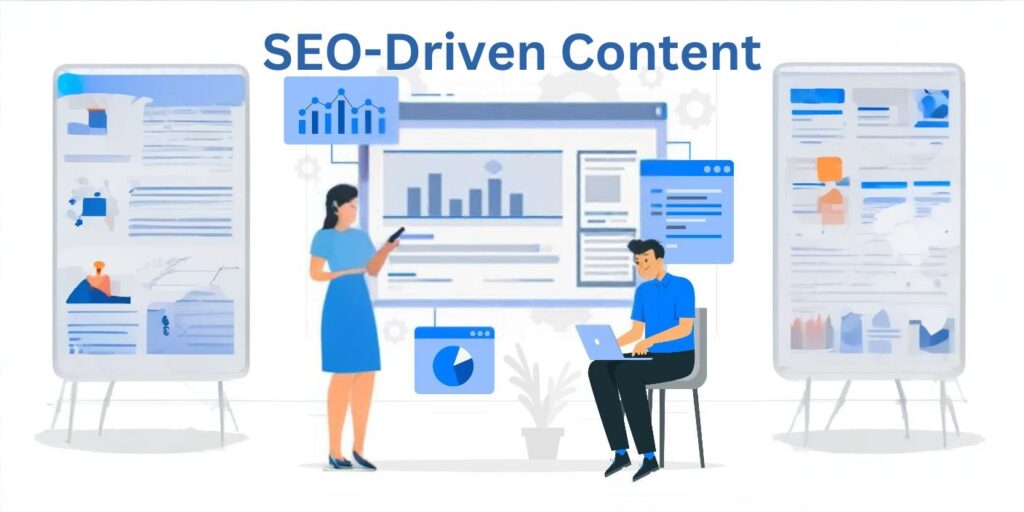

In the world of digital marketing, content is king, but not just any content—SEO-driven content. As search engines evolve, simply creating content isn’t enough to stand out. To grab the attention of both search engines and users, content must follow SEO principles. SEO-driven content makes your message easy to find, engaging, and valuable. In this article, we’ll explore why SEO-driven content is essential in today’s digital marketing. We’ll also discuss why it’s a must-have strategy for businesses. SEO-driven content helps drive traffic, increase brand awareness, and boost conversions.
SEO-focused content is content created to satisfy both search engines and readers. Its main goal is to improve visibility on search engine results pages (SERPs). At the same time, it provides meaningful, engaging, and valuable information to the audience.
This type of content achieves a balance between:
Addressing the searcher’s intent by answering their queries or solving their problems.
Optimization involves using on-page SEO techniques. These include keyword placement, writing meta descriptions, and proper structuring. These steps ensure the content aligns with search engine algorithms.
Engaging readers with compelling, original, and authoritative content that inspires trust and action.
In today’s digital world, crafting SEO-focused content isn’t just a nice-to-have skill—it’s a must-have. With over 4.9 billion people using the internet, standing out online is a challenge. It requires a mix of creativity and technical expertise. But how do you write content that ranks high on search engines and keeps your readers engaged? This guide will show you exactly how to balance these two essential goals to maximize your content’s visibility.

In today’s competitive digital landscape, simply writing content isn’t enough to capture the attention of your audience. To stand out, your content needs to be optimized for search engines. SEO-driven content is a powerful tool. It helps your content rank higher on search engines. At the same time, it engages and converts visitors effectively. This guide provides simple steps to create content that performs well on search engines. It also ensures your content delivers value to readers. By applying SEO principles, you can drive more organic traffic. This will improve your visibility and lead to long-term success in digital marketing.
Step – 1: Understand Your Audience and Keywords
Every great piece of SEO-focused content begins with understanding your audience. Ask yourself:
Once you know your audience, it’s time to research keywords. Use tools like Google Keyword Planner, Ahrefs, or SEMrush to identify keywords that match your target audience’s search intent. Focus on long-tail keywords — phrases like “how to improve website SEO in 2024″—because they are more specific and less competitive than shorter terms.
But don’t just stuff keywords into your content. Think of them as breadcrumbs that lead readers (and search engines) to valuable insights.
Step – 2: Create Content That Solves Problems
Search engines like Google prioritize content that answers questions, solves problems, or provides real value to users. This means your content should always align with search intent:
For example, if you’re targeting the keyword “SEO content writing tips,” ensure your content covers practical steps someone can take right away—as this blog does!
Step – 3: On-Page SEO Best Practices
On-page SEO is your secret weapon for ensuring that search engines and readers can easily understand your content. Here are some must-follow tips:
Step – 4: Enhance Readability and User Experience
Engaging content isn’t just about what you say; it’s about how you say it. Here are tips to make your content more reader-friendly:
Step – 5: Optimize for Mobile and Speed
Did you know that over 60% of web traffic comes from mobile devices? If your content isn’t mobile-friendly, you’re losing a massive audience. Here’s how to fix that:
Search engines also favor faster-loading websites, so every second counts!
Step – 6: Leverage Backlinks for Greater Authority
Backlinks—Backlinks are links from reputable websites that lead to your content. They are a powerful factor for ranking. To earn backlinks:
The more high-quality backlinks you earn, the more search engines will trust your content.
Step – 7: Measure and Refine Your Strategy
SEO isn’t a one-and-done effort. Regularly monitor your content’s performance using tools like Google Analytics and Google Search Console. Track metrics such as:
Identify what’s working and update underperforming content. Updating old posts can make them more effective. Add new information to keep them relevant. Optimize with better keywords to improve search rankings. Simplify and refine the content to enhance readability. These changes can bring fresh life to outdated posts.

In today’s digital world, SEO-driven content is essential for success. It boosts visibility, builds trust, drives traffic, and turns visitors into customers. Here’s why SEO-driven content is essential:
Search engines are the primary way people find information online. 93% of online experiences begin with a search engine. And appearing on the SERP, dramatically improves your chances of being seen.
Google and other search engines prioritize content that demonstrates Expertise, Authoritativeness, and Trustworthiness (E-A-T). Creating SEO-driven content with in-depth, accurate, and useful information positions your website as a trusted resource.
SEO-driven content emphasizes not just keywords but also readability, structure, and engagement. When you create content that’s easy to read, visually appealing, and answers users’ queries effectively, it improves the overall experience.
SEO allows you to reach the right audience by aligning content with user intent. Whether someone is searching for information, solutions, or products, well-optimized content ensures your website becomes their destination.
Unlike paid advertising, SEO-driven content generates sustainable and compounding returns over time. Once your content ranks well, it continues to drive organic traffic without additional investment.
Appearing consistently in search results for industry-relevant topics builds brand recognition. Over time, users begin to associate your brand with expertise in your niche.
SEO-driven content provides a better return on investment (ROI) than traditional advertising. It generates organic traffic at a lower cost than paid ads while attracting high-quality leads.
In nearly every industry, competitors are investing in SEO to capture market share. Without SEO-driven content, you risk falling behind.
With more people using the internet, especially on mobile devices, search engines greatly influence how content is accessed. By focusing on SEO-driven content, you adapt to evolving user behavior.
SEO-driven content enhances and supports other digital marketing efforts, such as:
SEO-driven content is a cornerstone of digital success. It boosts visibility, builds credibility, and delivers sustainable traffic. By investing in SEO-driven strategies, you ensure your content doesn’t just exist online but thrives.
In the fast-changing world of digital marketing, SEO-driven content is essential. It is more than just a strategy; it is the foundation of success. Writing engaging content is not enough. Your content must also be easy for search engines to find to make a real impact.
By applying SEO basics like keyword research, on-page optimization, and link-building, you can improve your content’s visibility. Combining these techniques with high-quality, problem-solving content ensures better rankings. It also helps your content connect with readers on a deeper level.
Creating SEO-driven content is an ongoing process. It involves knowing your audience, optimizing for search engines, and making your content easy to read. Regularly measuring and refining your efforts is key.
With the right approach, SEO-powered content becomes a powerful tool for digital marketing. It offers long-term visibility, more engagement, and higher conversion rates. As businesses continue to embrace the digital age, SEO-driven content will remain crucial. It helps build a strong online presence and ensures steady growth.
Remember, the key to long-term success is consistency. Keep creating, keep refining, and watch your content shine in search engine rankings.
Ready to elevate your content game? Contact Digialyst for expert SEO content solutions today!
SEO-driven content is strategically crafted content designed to rank high on search engines while delivering value to readers. It incorporates relevant keywords, user intent, and on-page SEO techniques to increase visibility and engagement.
SEO ensures that your content reaches the right audience by improving visibility on search engines. It helps drive organic traffic, build credibility, and achieve long-term marketing goals without relying heavily on paid ads.
Keyword research helps identify the terms and phrases your target audience is searching for. By using these keywords strategically, your content aligns with user intent and ranks higher on search engine results pages (SERPs).
Key on-page SEO practices include:
Backlinks from reputable websites signal authority and trustworthiness to search engines. They enhance your content’s credibility and boost its ranking potential.
Yes! By integrating keywords naturally, using conversational language, and focusing on solving user problems, you can create content that feels human and engaging while still optimized for search engines.
It’s ideal to review and update your content every 6-12 months. Adding fresh information, improving keyword usage, and refining readability keeps your content relevant and competitive.
With over 60% of web traffic coming from mobile devices, mobile-friendly content ensures a seamless user experience. Search engines prioritize mobile-optimized sites, so it's crucial for ranking.
Popular tools include:
Use tools like Google Analytics and Google Search Console to track metrics such as organic traffic, bounce rates, keyword rankings, and engagement rates. These insights help refine your strategy.